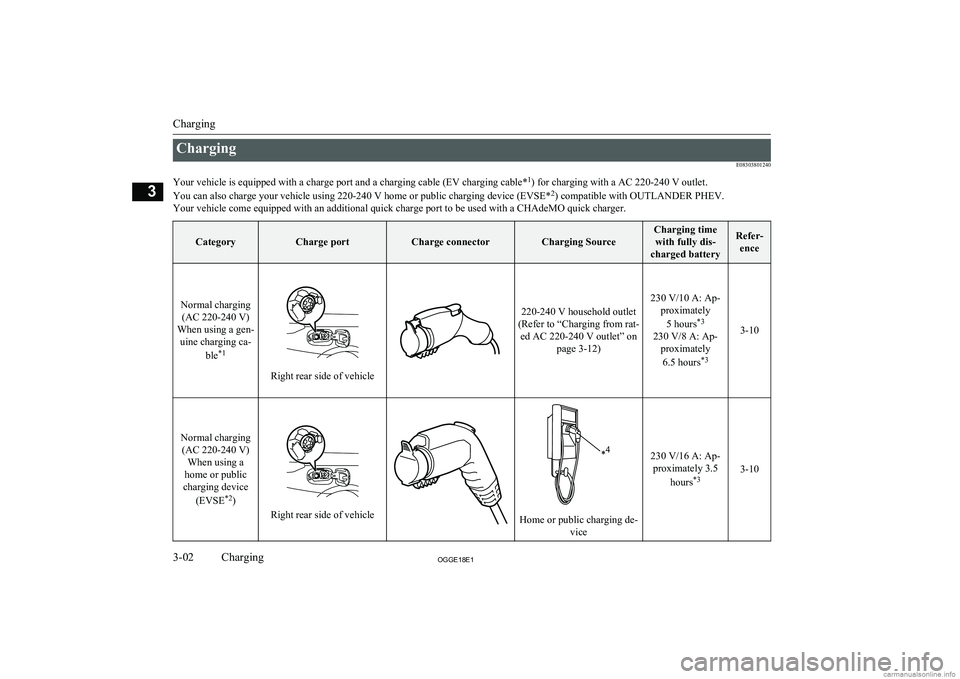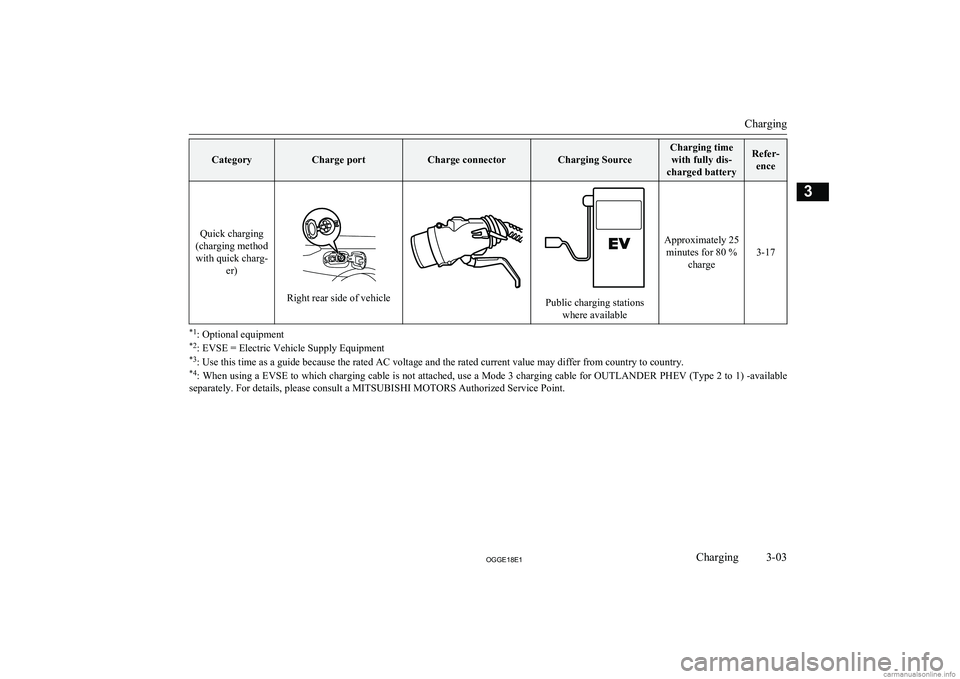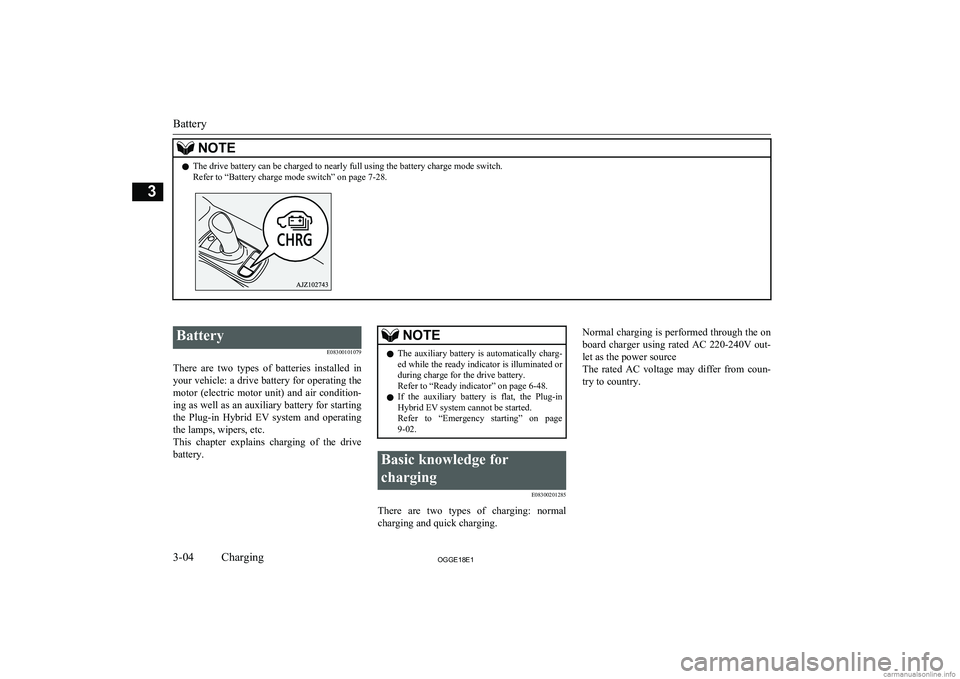2018 MITSUBISHI OUTLANDER PHEV charging
[x] Cancel search: chargingPage 37 of 538

NOTEl*1
: Refer to “PROPULSION POWER IS REDUCED warning display” on page 6-41.
Display of the “PROPULSION POWER IS REDUCED” warning display does not indicate a malfunction.
l *2
: Refer to “Ready indicator” on page 6-48.
l *3
: Refer to “Warning display list” on page 6-23.
l *4
: To warm up the drive battery, you should perform to register the wireless LAN device (which conforms to IEEE 802.11 b and supports iOS 4.1.0 and
subsequent OS version or Android 2.1.0 and subsequent OS version) for MITSUBISHI Remote Control to the vehicle. If the information of “
” mark on
the wireless LAN device is displayed, connect the EV charging cable as soon as possible.
Refer to “MITSUBISHI Remote Control*” on page 3-24. When using a home charging device or a public charging device (EVSE: Electric Vehicles Supply Equipment), charging and warm-up of the drive battery may be stopped.
While warming up the drive battery, the following phenomena may occur.
• The operation sound of on board equipment and the state of charge is displayed on the multi information display.
Refer to “Charging from rated AC 220-240 V outlet” on page 3-12.
• Inside of the vehicle may be heated automatically.
• The drive battery may not become full charge, or the remaining capacity of drive battery may decrease.
Fuel selection
E00200105041Recom-
mended fuelUnleaded petrol octane number(EN228)
95 RON or higherCAUTIONl The use of leaded fuel can result in serious
damage to the engine and catalytic convert- er. Do not use leaded fuel.NOTEl Poor quality petrol can cause problems such
as difficult starting, stalling, engine noise
and hesitation. If you experience these prob- lems, try another brand and/or grade of pet-
rol.
If the check engine warning lamp flashes,
have the system checked as soon as possible at a MITSUBISHI MOTORS Authorized
Service Point.Graphical expression for con-
sumer information
Identifier for petrol-type fuels
Fuel selection
2-13OGGE18E1General information2
Page 38 of 538

E5: Petrol fuel containing up to 2.7 % (m/m)
oxygen or up to 5.0 % (V/V) ethanol – Eg.
EN 228 compliant unleaded petrol
E10: Petrol fuel containing up to 3.7 % (m/m) oxygen or up to 10.0 % (V/V) ethanol
– Eg. EN 228 compliant unleaded petrol
The petrol engine are compatible with E5
type petrol (containing 5 % ethanol) and E10 type petrol (containing 10 % ethanol) con-forming to European standards EN 228.CAUTIONl Do not use more than 10 % concentration of
ethanol (grain alcohol) by volume.
Use of more than 10 % concentration may
lead to damage to your vehicle fuel system,
engine, engine sensors and exhaust system.Filling the fuel tank
E00200204393WARNINGlWhen handling fuel, comply with the safe-
ty regulations displayed by garages and
filling stations.
l Gasoline is highly flammable and explo-
sive. You could be burned or seriously in-
jured when handling it. When refueling
your vehicle, always put the operation mode of the power switch in OFF and
keep away from flames, sparks, and smoking materials. Always handle fuel in
well-ventilated outdoor areas.WARNINGl Before removing the fuel cap, be sure to
get rid of your body’s static electricity bytouching a metal part of the car or fuel
pump. Any static electricity on your body could create a spark that ignites fuel va-
pour.
l Perform the whole refueling process
(opening the fuel tank filler door, remov-
ing the fuel cap, etc.) by yourself. Do not let any other person come near the fuel tank filler. If you allowed a person to help
you and that person was carrying static electricity, fuel vapour could be ignited.
l Do not perform charging and refueling at
the same time. If you charged with staticelectricity, fuel vapour could be ignited by
the discharge spark.
l Do not move away from the fuel tank fill-
er until refueling is finished. If you moved
away and did something else (for exam- ple, sitting on a seat) part-way through
the refueling process, you could pick up a fresh charge of static electricity.
l Be careful not to inhale fuel vapour. Fuel
contains toxic substances.
l Keep the doors and windows closed while
refueling the vehicle. If they were open, fuel vapour could get into the cabin.
l If the tank cap must be replaced, use only
a MITSUBISHI MOTORS genuine part.CAUTIONl The fuel in the fuel tank may not be con-
sumed and it may stagnate for a long timeCAUTIONdepending on the use situation of the vehi-cle, the quality of fuel may change, and it
may have a bad influence on the engine or the parts of a fuel system.
Observe the following instructions for pre- vention.
• Press the battery charge switch to start the
engine within three months at once.
Refer to “Battery charge mode switch” on page 7-28.
• Refill the fuel more than 15 litres at once
within three months. If the fuel remaining display will be below half, you can refill
the fuel more than 15 litres certainly.
Refer to “Fuel remaining display screen” on page 6-09.
Fuel tank capacity
45 litres
Refueling
1. Before filling with fuel, stop the plug-in
hybrid EV system.
2. The fuel tank filler is located on the rear
left side of your vehicle.
Filling the fuel tank
2-14OGGE18E1General information2
Page 43 of 538

Charging.............................................................................................. 3-02
Battery................................................................................................. 3-04 Basic knowledge for charging.............................................................3-04
EV charging cable*............................................................................. 3-07
Normal charging (charging method with rated AC 220-240V outlet).............................................................................3-10
Quick charging (charging method with quick charger)...................... 3-17
Charging troubleshooting guide.......................................................... 3-21 MITSUBISHI Remote Control*......................................................... 3-24Charging
OGGE18E13
Page 44 of 538

ChargingE08303801240
Your vehicle is equipped with a charge port and a charging cable (EV charging cable* 1
) for charging with a AC 220-240 V outlet.
You can also charge your vehicle using 220-240 V home or public charging device (EVSE* 2
) compatible with OUTLANDER PHEV.
Your vehicle come equipped with an additional quick charge port to be used with a CHAdeMO quick charger.CategoryCharge portCharge connectorCharging Source
Charging time with fully dis-
charged batteryRefer- ence
Normal charging(AC 220-240 V)
When using a gen- uine charging ca-
ble*1
Right rear side of vehicle
220-240 V household outlet
(Refer to “Charging from rat- ed AC 220-240 V outlet” on page 3-12)
230 V/10 A: Ap-proximately
5 hours *3
230 V/8 A: Ap- proximately
6.5 hours *3
3-10
Normal charging
(AC 220-240 V) When using a
home or public
charging device
(EVSE *2
)
Right rear side of vehicleHome or public charging de-
vice
230 V/16 A: Ap-proximately 3.5
hours *3
3-10
Charging
3-02OGGE18E1Charging3
Page 45 of 538

CategoryCharge portCharge connectorCharging Source
Charging timewith fully dis-
charged batteryRefer- ence
Quick charging
(charging method with quick charg- er)
Right rear side of vehiclePublic charging stationswhere available
Approximately 25minutes for 80 % charge
3-17
*1: Optional equipment
*2 : EVSE = Electric Vehicle Supply Equipment
*3 : Use this time as a guide because the rated AC voltage and the rated current value may differ from country to country.
*4 : When using a EVSE to which charging cable is not attached, use a Mode 3 charging cable for OUTLANDER PHEV (Type 2 to 1) -available
separately. For details, please consult a MITSUBISHI MOTORS Authorized Service Point.
Charging
3-03OGGE18E1Charging3
Page 46 of 538

NOTElThe drive battery can be charged to nearly full using the battery charge mode switch.
Refer to “Battery charge mode switch” on page 7-28.
Battery
E08300101079
There are two types of batteries installed in your vehicle: a drive battery for operating the
motor (electric motor unit) and air condition-
ing as well as an auxiliary battery for starting the Plug-in Hybrid EV system and operatingthe lamps, wipers, etc.
This chapter explains charging of the drive battery.NOTEl The auxiliary battery is automatically charg-
ed while the ready indicator is illuminated orduring charge for the drive battery.
Refer to “Ready indicator” on page 6-48.
l If the auxiliary battery is flat, the Plug-in
Hybrid EV system cannot be started.Refer to “Emergency starting” on page
9-02.Basic knowledge for
charging E08300201285
There are two types of charging: normalcharging and quick charging.
Normal charging is performed through the on
board charger using rated AC 220-240V out-
let as the power source
The rated AC voltage may differ from coun-
try to country.
Battery
3-04OGGE18E1Charging3
Page 47 of 538

WARNINGlTo reduce the risk of electric shock or fire
due to electric leak, always use an earthed
outlet protected by a residual current de-
tector, rated for amperage equal to or greater than the value specified by MITSUBISHI MOTORS , and that is con-
nected to a dedicated branch circuit. If
the circuit is shared, and another electri- cal device is being used at the same time
as the vehicle is charging, the circuit may heat abnormally, the breaker may trip
and the circuit may cause adverse inter- ference on the household electrical appli-
ances such as TVs and audio systems.
l It is possible to charge even in rain or
snow. However, be sure to pay attention to the following:
• Do not touch normal charge port, nor-
mal charge connector, outlet and plug with wet hands.
• Keep away from water when connect-
ing the normal charge port, normal
charge connector, outlet and plug.
• Do not perform the charging in the out
of doors when heavy rain, heavy snow, strong winds, and when bad weather is
expected.
• Do not charge if there is possibility a
lightning strike. When thunder rum- bling begins suddenly during normal
charging, do not touch the vehicle and the EV charging cable and turn off the
breaker.WARNINGl If water goes into the normal charge port
or the normal charge connector, it couldcause a short circuit, a fire and an electric shock.
Be sure to completely close the charging
lid and the inner lid and do not leave the EV charging cable in an outdoors.
l If the connected part of the charging plug
has been buried in snow while charging, turn off the hand switch or the breaker
connected with the outlet first, then re- move the snow and disconnect the charg-
ing plug. If your vehicle body has been buried in snow while charging, remove
the snow and then disconnect the charge connector.
l When you perform the normal charging
at away from home, some normal charg-
ers may not correspond to your vehicle. Consult an administrator or a maker of
the normal charger that it corresponds to your vehicle before using it. Also perform
normal charging according to the operat-
ing procedure indicated on the body of
normal charger.
l Do not open the charging lid for anything
other than charging and using the exter-
nal power feed.CAUTIONl Do not attempt to perform a jump start on
the auxiliary battery at the same time that the
drive battery is being charged. Doing so may
damage the vehicle or charging cable and
could cause injury.
Refer to “Emergency starting” on page 9-02.NOTEl If you open the charging lid with the opera-
tion mode of the power switch is ON, a buz- zer sounds approximately 10 minutes inter-mittently to alert the charging cannot be star- ted. If you close the charging lid or put theoperation mode in OFF, the buzzer stops.
l If you insert the charge connector to the
charge port with the operation mode is ON,
a buzzer sounds continuously approximately
10 minutes to alert the charging cannot be started.
If you pull the charge connector out or put the operation mode in OFF, the buzzer stops.
l Repeatedly performing only quick charging
may reduce the battery capacity.
In usual charge, normal charging is recom-
mended.
l To maintain the capacity of the drive battery,
the following is recommended:
• If you repeatedly perform only the quick
charging, fully charge the vehicle in nor- mal charging every 2 weeks.
Basic knowledge for charging
3-05OGGE18E1Charging3
Page 48 of 538

NOTE•Do not repeat charging near the full
charge level.
l The quick charging gives priority when the
normal charging and the quick charging are performed at the same time. At this time, thenormal charging will be stopped.
l Even if the operation mode of the power
switch is OFF, you may hear the operating sound of the cooling fan for cooling the
drive battery during charging.
This is not a malfunction.
l If your vehicle is not used for a long time,
check the energy level gauge every 3 months. If the gauge shows 0, charge thedrive battery until some indication appears.
Alternatively, start the Plug-in Hybrid EV
System. Then the engine will automatically start to charge the drive battery. Wait until the engine automatically stops, then put theoperation mode of the power switch in OFF.
l In the event of an electrical power outage
while charging, charging restarts automati-
cally with the restoration of electricity.Charge port courtesy lamp
E08304300157
The charging port courtesy lamp (A) illumi-
nates when the charging lid is opened while
the select position is in “P” (PARK) position. It goes off automatically after approximately3 minutes.
If you want to turn on it again, press the charging port courtesy lamp switch (B).
When charging is started, the charging port
courtesy lamp blinks three times.NOTEl The charging port courtesy lamp illuminat-
ing time can be adjusted.
For details, please consult a MITSUBISHI
MOTORS Authorized Service Point.
l If the
MITSUBISHI Remote Control (if so
equipped) is operated when the charging
port courtesy lamp is off, the lamp may illu-
minate.
Basic knowledge for charging
3-06OGGE18E1Charging3